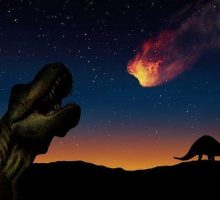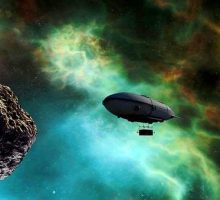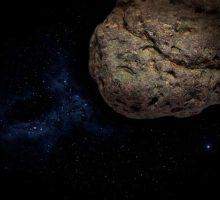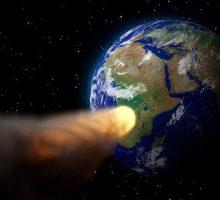- What Are Meteors and How Do They Form?
- “The Different Types of Meteoroids and Their Impact on Earth”
- “Famous Meteor Craters Around the World”
- “The Science of Meteor Showers: What Causes Them and How to Observe Them”
- “The Role of Meteoroids in the Formation of Planets”
- “The Potential Dangers of Large Meteoroids Impacting Earth”
- “The Hunt for Meteorites: A Thrilling Adventure in Space Science”
- “Meteoroids and Astrobiology: Could They Hold Clues to Life Beyond Earth?”
- “Meteoroids and Space Exploration: Opportunities and Challenges”
- “The Cultural Significance of Meteoroids: Myths, Legends, and Folklore”
What Are Meteors and How Do They Form?
Are you ready to explore the fascinating world of meteors? Meteors are celestial bodies that have captured the imagination of people for centuries. These blazing streaks of light that we see in the night sky are not only a sight to behold but also hold important clues about the formation of our solar system. In this beginner’s guide, we will delve into the basics of meteors, their origins, and how they are formed.
Meteors, also known as shooting stars, are streaks of light that appear in the night sky when small celestial objects called meteoroids enter the Earth’s atmosphere. When meteoroids collide with the Earth’s atmosphere, they create a burst of light that we see as a shooting star. Most meteoroids are smaller than a grain of sand and burn up completely before they reach the Earth’s surface. However, larger meteoroids can survive the journey and crash onto the Earth’s surface, creating impact craters.
But where do these meteoroids come from, and how are they formed? Meteoroids are debris left behind by comets and asteroids in our solar system. Comets are made of ice and rock and leave a trail of debris as they orbit the sun. Asteroids, on the other hand, are made of rock and metal and can also break apart, leaving behind debris. These debris eventually become meteoroids and can be found throughout our solar system.
When a meteoroid collides with the Earth’s atmosphere, it creates friction that causes it to heat up and glow, creating the streak of light that we see. This process is called ablation, and it causes the meteoroid to burn up completely or partially before it reaches the ground. The heat generated during ablation is also responsible for the sound of a sonic boom that is often heard when a large meteoroid enters the Earth’s atmosphere.
The Different Types of Meteoroids and Their Impact on Earth
Meteors, or shooting stars, are fascinating celestial events that occur when small celestial objects called meteoroids enter the Earth’s atmosphere. These meteoroids come in various types and sizes, and their potential impact on Earth can range from harmless streaks of light to catastrophic collisions. In this article, we will discuss the different types of meteoroids, including asteroids, comets, and meteorites, and their potential impact on Earth.
Asteroids are rocky or metallic objects that orbit the sun. They range in size from small boulders to large objects several hundred kilometers in diameter. Asteroids that come close to Earth are known as Near-Earth Objects (NEOs) and can pose a potential threat to our planet. In 1908, a small asteroid exploded over Tunguska, Russia, releasing energy equivalent to several atomic bombs and flattening trees over an area of 2,000 square kilometers. While such events are rare, the potential for a catastrophic asteroid impact is a concern for astronomers and space agencies around the world.
Comets, on the other hand, are icy objects that also orbit the sun. They are composed of rock, dust, and frozen gases such as water, carbon dioxide, and methane. When comets approach the sun, they heat up and release gas and dust, creating a visible coma and sometimes a tail. Comets are the source of most meteor showers and can also pose a potential threat to Earth if their orbit intersects with our planet’s.
Meteorites are meteoroids that survive the journey through the Earth’s atmosphere and reach the ground. They can provide important insights into the formation of our solar system and the universe. There are three main types of meteorites: stony, iron, and stony-iron. Stony meteorites are the most common and are composed of silicate minerals. Iron meteorites are composed of iron-nickel alloys, while stony-iron meteorites are a mixture of both.
Famous Meteor Craters Around the World
Meteor impacts have played a significant role in shaping our planet’s history, creating some of the most awe-inspiring geological features on Earth. Meteor craters are a testament to the immense power and destructive force of these cosmic visitors. In this article, we will explore some of the most famous meteor craters around the world, from the iconic Barringer Crater in Arizona to the Chicxulub Crater in Mexico, which played a crucial role in the extinction of the dinosaurs.
The Barringer Crater, also known as Meteor Crater, is one of the most well-known meteor impact sites in the world. It is located in northern Arizona and was formed approximately 50,000 years ago when a nickel-iron meteoroid, estimated to be about 50 meters in diameter, struck the Earth’s surface. The impact created a crater almost a mile wide and 570 feet deep, which is still visible today. The Barringer Crater is now a popular tourist attraction and has been the site of numerous scientific studies.
Another famous meteor crater is the Chicxulub Crater, located on the Yucatan Peninsula in Mexico. This crater was formed approximately 66 million years ago when a massive asteroid, estimated to be about 10 kilometers in diameter, struck the Earth. The impact created a crater approximately 180 kilometers in diameter and is believed to have caused the extinction of the dinosaurs and many other species. The Chicxulub Crater has been extensively studied by scientists and has provided valuable insights into the nature of large-scale meteor impacts.
The Vredefort Crater in South Africa is another notable meteor impact site. It is the largest confirmed impact crater on Earth, with a diameter of approximately 300 kilometers. The crater was formed approximately 2 billion years ago when a massive asteroid struck the Earth’s surface. The impact created a crater that is now largely eroded, but the geological features it created can still be seen in the surrounding landscape.
The Science of Meteor Showers: What Causes Them and How to Observe Them
Meteor showers are one of the most spectacular astronomical events that can be observed from Earth. These dazzling displays of shooting stars are caused by cosmic debris, known as meteoroids, entering the Earth’s atmosphere and burning up. In this article, we will delve into the science behind meteor showers, exploring what causes them and how to observe them.
Meteor showers occur when the Earth passes through the debris left behind by comets or asteroids. As these objects orbit the Sun, they leave behind a trail of cosmic debris, consisting of small particles ranging in size from dust to rocks. When the Earth’s orbit intersects with one of these debris trails, the particles enter the Earth’s atmosphere and burn up, creating the bright streaks of light we call meteors.
One of the most well-known meteor showers is the Perseids, which occurs annually in August. This meteor shower is caused by the debris left behind by Comet Swift-Tuttle and can produce up to 100 meteors per hour at its peak. Other popular meteor showers include the Leonids, the Geminids, and the Quadrantids.
Observing meteor showers is relatively easy and requires no special equipment. The best time to observe a meteor shower is during its peak, when the most meteors are visible. It’s best to find a location away from city lights with a clear view of the sky. Lie on your back and look up at the sky, allowing your eyes to adjust to the darkness. Meteors can appear anywhere in the sky, so it’s best to keep your gaze fixed on one spot and be patient.
The Role of Meteoroids in the Formation of Planets
Meteoroids, or small particles of cosmic debris, played a critical role in the formation of the planets in our solar system. These tiny fragments of rock and ice provided the building blocks for the planets, helping to shape the worlds we see today. In this article, we will explore the role that meteoroids played in the formation of our solar system and the planets within it.
The early solar system was a chaotic and violent place, with countless meteoroids and other debris colliding and merging to form larger bodies. These collisions eventually led to the formation of the planets, including Earth. As meteoroids and other debris collided and merged, they formed larger and larger bodies, eventually reaching the size of small planets. These small planets, in turn, collided and merged to form the larger planets we see today.
The meteoroids that collided and merged to form the planets were made up of a variety of materials, including rock, ice, and metal. These materials helped to shape the planets’ composition, determining their density, size, and other properties. For example, the presence of a large amount of iron in a planet’s core can lead to the formation of a magnetic field, which can help protect the planet from solar winds and other cosmic radiation.
Meteoroids also played a crucial role in the evolution of the planets after their formation. Meteoroids that impacted the planets could cause significant changes to their surface, such as the formation of craters or the creation of new geological features. These impacts could also bring new materials to the surface, including water and organic compounds, which could play a role in the development of life.
The Potential Dangers of Large Meteoroids Impacting Earth
The impact of a large meteoroid on Earth has the potential to be catastrophic, causing widespread destruction and loss of life. While the likelihood of such an event occurring is relatively low, the consequences could be devastating. In this article, we will examine the potential dangers of large meteoroids impacting Earth and the measures being taken to protect our planet.
Large meteoroids, such as asteroids and comets, pose the greatest risk to Earth. These objects can be several kilometers in size and, if they were to impact Earth, could release energy equivalent to thousands of nuclear bombs. The impact would cause widespread destruction, including shockwaves, tsunamis, and firestorms, and could even trigger a global climate change event.
The potential danger posed by large meteoroids has led to efforts to detect and track these objects, in order to predict their trajectory and take action to prevent impact. One such effort is the NASA Near-Earth Object (NEO) program, which aims to identify and track potentially hazardous objects and assess their risk to Earth. In addition, several space agencies and private companies are developing technologies to deflect or redirect incoming meteoroids, such as the use of solar sails or kinetic impactors.
Despite these efforts, there is still much that remains unknown about the potential impact of large meteoroids on Earth. Some scientists believe that a large meteoroid impact could be responsible for the extinction of the dinosaurs, and that a similar event could occur again in the future. As such, it is important to continue research efforts into the detection and prevention of large meteoroid impacts, in order to protect our planet and its inhabitants.
The Hunt for Meteorites: A Thrilling Adventure in Space Science
The hunt for meteorites is a thrilling adventure that takes space science enthusiasts to some of the most remote and desolate places on Earth. Meteorites are remnants of our solar system’s early history, and their study provides valuable insights into the formation and evolution of our planetary system. In this article, we will explore the excitement and challenges of hunting for meteorites.
Meteorites are rocks that have fallen to Earth from space. They can come from asteroids, comets, and other celestial bodies, and they offer scientists a unique opportunity to study the materials that make up our solar system. The search for meteorites often involves traveling to remote locations, such as the Antarctic ice fields or the Sahara Desert, where the chances of finding these precious stones are higher.
One of the challenges of hunting for meteorites is distinguishing them from ordinary rocks. Meteorites are often dark in color, and they can have distinctive features, such as a fusion crust or chondrules, that set them apart from terrestrial rocks. Meteorite hunters use a variety of tools, such as metal detectors and GPS devices, to aid in their search, and they must have a keen eye and a lot of patience.
Once a meteorite has been found, it is carefully analyzed and classified by scientists. This involves examining its chemical composition, mineralogy, and structure, as well as determining its origin and age. Meteorites can provide clues about the early history of our solar system, including the formation of the planets and the processes that shaped their surfaces.
The hunt for meteorites is not just limited to scientists and researchers. Amateur collectors and enthusiasts also take part in the search, and there are many organizations and clubs dedicated to the hobby of meteorite hunting. Some meteorites can be quite valuable, and they can fetch high prices at auctions and in private sales.
Meteoroids and Astrobiology: Could They Hold Clues to Life Beyond Earth
Meteoroids, or small particles of space debris, could potentially hold important clues to the origins of life beyond Earth. These particles are believed to have played a significant role in the delivery of organic molecules, which are the building blocks of life, to our planet. In this article, we will explore the role of meteoroids in astrobiology, the study of life in the universe.
Scientists believe that meteoroids could have delivered organic molecules to Earth during the early stages of our planet’s formation. These molecules, such as amino acids and nucleotides, are the building blocks of proteins and DNA, which are essential for life as we know it. The delivery of these molecules by meteoroids is known as panspermia, and it is one of the leading theories on the origins of life on Earth.
Meteoroids could also potentially hold clues to the search for extraterrestrial life. Scientists are studying the chemical composition of meteoroids to look for signs of organic molecules and other indicators of life. By analyzing these particles, researchers hope to gain a better understanding of the conditions that are necessary for the development and evolution of life in the universe.
One of the challenges in studying meteoroids and their potential for astrobiology is the difficulty in obtaining and analyzing these particles. Meteoroids are small and rare, and they are often destroyed upon entering Earth’s atmosphere. However, recent advances in technology, such as space-based telescopes and sample-return missions, are making it possible for scientists to study these particles in greater detail.
In addition to the study of meteoroids, astrobiology also involves the search for extraterrestrial life through the exploration of other planets and moons in our solar system and beyond. This includes the search for habitable environments, the detection of biosignatures, and the study of the evolution of life in extreme environments.
Meteoroids and Space Exploration: Opportunities and Challenges
Meteoroids, the small particles of space debris that are often created by comets and asteroids, could both benefit and pose challenges to space exploration missions. In this article, we will explore the opportunities and challenges that meteoroids present for future space exploration.
One potential benefit of meteoroids is that they could serve as a source of valuable resources for space exploration missions. Some meteoroids contain water and other materials that could be extracted and used to sustain human life and support future space exploration activities. For example, water can be split into hydrogen and oxygen, which can be used for rocket fuel and life support systems.
However, meteoroids also pose significant challenges for space exploration. The small size and high speed of meteoroids make them difficult to detect and avoid, posing a potential hazard to spacecraft and astronauts. Meteoroids can cause damage to spacecraft and other equipment, and even small impacts can create dangerous debris that can pose a threat to other objects in space.
To mitigate the risks posed by meteoroids, space agencies are developing advanced detection and mitigation technologies. For example, NASA’s Deep Space Network includes a system of ground-based telescopes and radars that can track and monitor potentially hazardous asteroids and other space debris. Additionally, spacecraft can be equipped with shields and other protective measures to minimize the risk of damage from meteoroid impacts.
Another challenge posed by meteoroids is the difficulty of studying them in their natural environment. Because meteoroids are small and short-lived, they are difficult to observe and study in detail. However, advances in space-based telescopes and sample-return missions are making it possible to study meteoroids in greater detail, which could help us better understand the composition and behavior of these important space objects.
The Cultural Significance of Meteoroids: Myths, Legends, and Folklore
Meteoroids have captivated the human imagination for centuries, inspiring myths, legends, and folklore across cultures around the world. In this article, we will explore the cultural significance of meteoroids and their impact on human history.
In many ancient cultures, meteoroids were seen as divine or supernatural in origin. The Greeks believed that shooting stars were the fiery breath of gods and goddesses, while the Norse associated them with the god Thor’s hammer. The Chinese believed that meteoroids were the manifestation of dragons, and the Aztecs believed that meteoroids were the messengers of their god of war, Huitzilopochtli.
Many cultures also believed that meteoroids had powerful healing or magical properties. In medieval Europe, meteoric iron was believed to be a powerful weapon against evil spirits and demons. In ancient Egypt, meteoroids were believed to have healing properties and were used in medical treatments.
Meteoroids have also played a significant role in modern culture, inspiring science fiction stories and popular films. The concept of extraterrestrial life and alien civilizations is often associated with meteoroids and other space objects.
Meteoroids have also inspired artists and designers, with their unique shapes and patterns influencing everything from jewelry and clothing to architecture and industrial design.
Despite their cultural significance, meteoroids also pose a potential threat to human safety and civilization. The impact of a large meteoroid could have catastrophic consequences, as evidenced by the extinction of the dinosaurs. As such, efforts are being made to better understand and mitigate the risks posed by meteoroids to our planet.













